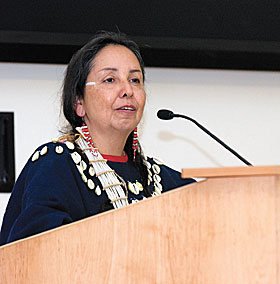  |
| HOME | THIS ISSUE | CALENDAR | GRANTS | BACK ISSUES | < BACK | NEXT > |
Native American land plagued by environmental damage, speaker says by Scott Brinckerhoff - November 6, 2006
|
||||
| In honor of Native American Heritage Month, two guest speakers recounted Wednesday night the tribulations of the Lakota Sioux and the Black Seminoles at the hands of early United States governments. Author and activist Charmaine White Face described the Lakota as a proud people determined to hold onto their heritage. James Madison University Professor Joe Opala offered a similar assessment of the Black Seminoles, the descendants of slaves brought to the New World from Sierra Leone.
Opala's story was primarily a history lesson about the little-known but prominent role the Sierra Leoneans played in the Deep South in the early to mid-1800s, while White Face presented an urgent call for action to halt environmental damage caused by the U.S. government on Lakota lands. That damage, she said, is now spreading across the country. White Face said the United States has "smothered" an 1868 treaty that was supposed to have established her tribe's land as a sovereign nation in the Black Hills of South Dakota. Instead of honoring the treaty, she said, the government has allowed extensive open pit mining of uranium and other elements, to the detriment of vast aquifers and the air itself. As described by White Face, the decline of the Sioux nation is astonishing. It once covered 14 states and three Canadian provinces and included seven sub-nations, of which the Lakota are one. The Sioux economy revolved around buffalo, which were decimated by whites who went on to mine sacred Lakota lands, unleashing radiation. "People are being exposed to dangerous levels of radiation," she told the audience. White Face cited the case of Bullhead, an Indian village built along South Dakota's Grand River. People there are dying of thyroid and other cancers at an alarming rate; babies are often stillborn; and calls for help from the state and federal governments have gone unheeded, she said. Her message: "We are all related." Educated as a biologist, White Face noted that aquifers cover massive areas of the continent, rivers empty into one another, radioactive dust is carried by the wind, and poisons in the soil nourish grass and feed crops that eventually work their way into the food people eat. White Face urged the audience to support efforts by her group, Defenders of the Black Hills, to compel governments to clean up residue at hundreds of mines and to encourage the United Nations General Assembly to pass an indigenous peoples human rights resolution that would include her tribe. Opala, who spent 17 years in Sierra Leone, starting as a Peace Corps volunteer in the 1970s, has spent much of his career studying the people who became known as Black Seminoles and their language, called Gullah. Like White Face, Opala described a native people whose treatment at the hands of white Europeans was shameful. Brought to the United States from Sierra Leone as slaves, a million are estimated to have died crossing the Atlantic. Those who survived lived in Georgia and South Carolina and brought with them extensive knowledge of rice growing, which became a vital part of the early U.S. economy. But the slave traders also brought new diseases with them from Africa, including malaria and yellow fever. The Sierra Leoneans were far more resistant than the whites, and in time, the slaves began to outnumber whites. They also began to escape, Opala said, and Florida - dominated at the time by the Spanish - welcomed them. The slaves aligned with the Seminole Indians of Florida and became known as the Black Seminoles. They distinguished themselves as fierce fighters who conducted an effective guerrilla war from 1835 to 1842 against the United States Army in the wilderness of Florida. The Army had been charged with returning the Black Seminoles to bondage, since slavery was the law of the land, and the idea of having "free" slaves in Florida did not sit well with the government - even though many of these "slaves" had in fact been born free. The Black Seminoles fought the Army to a standstill, and ultimately signed a treaty that allowed them to live in peace in Oklahoma and other locations. In modern times, Opala has accompanied Black Seminoles from the United States to their ancestral home in Sierra Leone, where he said the U.S. contingent is always amazed to find familiar music, food, language, and culture. |
| ADVANCE HOME UCONN HOME |

